 Leading Blog | Posts by Month |
 Leading Blog | Posts by Month |
03.31.18

LeadershipNow 140: March 2018 Compilation
See more on
Posted by Michael McKinney at 07:29 AM
03.26.18

Getting to US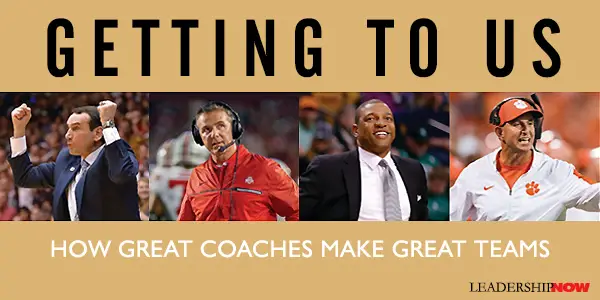
S Davis asks, “How do great coaches turn a collection of individuals into a coherent us?” He narrows it down to four personal qualities that are the core requirements all great coaches must have in order to get a group of individuals to Us. In Getting to Us, Seth Davis interviewed nine coaches of football and basketball, college and pro. And not only the coaches but also their wives and families, their friends, their players, and colleagues. Nine very different men with very different personalities. This is really the task of every leader, but interviewing sports figures is a good place to start learning about building teams that can perform at a consistently high level. The four core qualities form what he calls the PEAK profile: Persistence, Empathy, Authenticity, and Knowledge. In each of the nine coaches' lives, their PEAK profile was forged in different ways. It is interesting to read how each one of them was transformed by life experiences to learn persistence and empathy, how to be themselves, and how they acquired and continue to acquire the knowledge necessary to excel in their profession. You’ll find that it is a lot of small things consistently done right, that brings them success. At the same time, there is the humility to modify what needs to be modified for the sake of the team. It is interesting too, that while each possesses these four qualities, they each express them in unique ways so that there is no secret to replicate. They each had to learn to do what was right for them.
Empathy is the most important of all of the qualities. Empathy is being sensitive to the feelings of others. “A great coach must find ways to learn about his players, taking time to acquire the critical information that will lead him to understand how the player’s mind, heart, and guts operate.” Authenticity is remaining true to yourself and acting accordingly. “What makes them great coaches is their refusal to be something they are not.” It’s finding what works for you and not deviating from it, “particularly in those critical moments when the team must function as a single unit or suffer defeat.” Of course, the team has to believe that you have to believe that you know what you are doing. “Acquiring this knowledge take time and passion.” It’s a life-long pursuit. But there must be humility in the mix. “Knowledge without adaptability will eventually diminish a leader’s effectiveness. People change, games change, times change. Life authenticity, knowledge is an important step on the pathway to trust.” Here are some of the instructive excerpts from several of the coaches he profiled: Urban Meyer—Head football coach of the Ohio State Buckeyes His sabbatical taught him the importance of living a balanced life and conserving energy, which replenished his persistence. Having to face his own weaknesses and limitations deepened his empathy. The time off gave him a chance to reevaluate what was important to him, which reset his authenticity. Tom Izzo— Head Basketball Coach of the Michigan State Spartans The principles he learned in the family store: Show up. Work hard. Give back. Stay humble. “From day one he creates a family atmosphere and makes it known that he cares about you as an individual.” “I spend time with my players. That’s how I get to know them and can determine which way I need to go with them.” It takes more than a coach to get to Us. “I’ve always said, a player-coached team is much better than a coach-coached team.” “I worry about all the time spent on Twitter. That’s why there are no leaders on teams anymore. Kids can’t communicate. … We’re teaching kids that they should have your own ‘brand.’ Be your own guy. So now at fifteen, fourteen, thirteen, it’s me me me me me me. This is not about old school/new school. It’s about right school/wrong school.” Mike Krzyzewski—Head Basketball Coach of the Duke University Blue Devils [and that’s Sha-SHEF-ski] “Failure is not a destination, and you’re never going to do it alone.” Practice plans were scheduled down to the minute, but they also included notes explaining how each drill would prepare the team for its next opponent. That allowed his players to visualize the big picture. “I don’t coach for winning. I coach for relationships.” He wants his players to be instinctive, not calculating—to follow the courage of their convictions, just as his grandparents did when they set sail for America. Instinctiveness begets adaptability. Doc Rivers—Head Coach for the Los Angeles Clippers It is through this balance between coldness and empathy that Doc Rivers gets his team to Us. When critical moments arise, he doesn’t play the victim and he doesn’t want a hug. He’d rather pivot and get moving, trusting that is players will follow. “I learned from [Pat] Riley that the key to coaching is to get a group of players to believe there’s one agenda and that you have the same agenda as them. If you can do that, your players are going to do whatever they can do for you.” Brad Stevens—Head Coach for the Boston Celtics As a college player to his coach: “What are supposed to do, just lay down for these guys?”—[Coach Bill] Fenlon gave him his first lesson on leadership. “No, you should play hard,” he said. “But do it in a way that brings them along. Don’t create a divide.” Stevens says, “I became content when I came to the conclusion of, ‘Hey moron, it’s not about you. It’s about being as good of a teammate as you can be and putting your best foot forward every day.’” “Do you want to be around somebody who lifts you up or somebody that breaks you down? That’s why whenever people ask me what’s your leadership style, my answer is, ‘It should be you.’ There’s an authenticity that is needed for leadership. If it’s not real, then it’s not going to work.” “I think a lot of people in sports have missed the boat on mental health. You have to be empathetic in knowing that everybody has their own lives, and everybody has something tough going on. You need to make sure you understand that before you coach them.” “Toughness is doing the next right thing.” “All the good ones want to be coached.” 
Posted by Michael McKinney at 11:19 PM
03.23.18

What if Sellers Behaved as Leaders?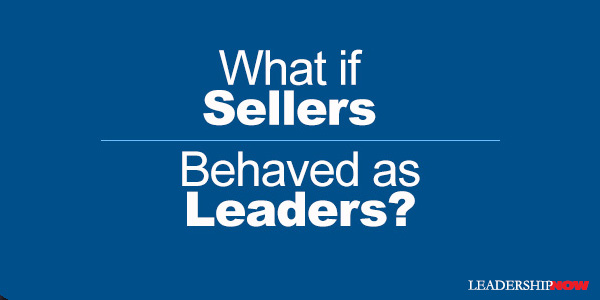
J In Stop Selling and Start Leading, the authors report that buyers what sellers who create personalized value and build bonds of trust, sellers who provide a meaningful and relevant experience, and sellers who demonstrate genuine leadership. Your buyers want you to inspire and motivate them while giving them an opportunity to participate in creating something extraordinary. They want you to collaborate with them, strengthen them, and encourage them in the process. This book demonstrates how to change from a selling mindset to a leadership mindset that buyers want. Using the Five Practices of Exemplary Leadership they found that sales effectiveness, like leadership effectiveness, can be significantly increased by choosing to behave differently. Without a doubt, leaders are always selling. Briefly the Five Practices are: Model the Way The first step is getting in touch with your personal values and beliefs. It an inside job. Selling from who you are will give you credibility. “Buyers are on the lookout for seller behaviors that demonstrate credibility, reliability, relate-ability, and an orientation focused mostly on the interests of others.” Inspire a Shared Vision Like shared values, a shared vision requires finding common ground with your buyers. Translate the solution you are selling into benefits relevant so the buyer so that they can clearly see themselves a part of it. “Exemplary leaders don’t impose their visions of the future on people; they liberate the vision that’s already stirring in their constituents.” Create a story. “When you weave the emotional connection to what matters most to the buyer together with the logical case for change, you animate the vision.” Challenge the Process A seller who leads is always listening and always learning. They are always looking for ways to improve and challenge the status quo. Take the initiative to find dissenting and diverse views. “Making assumptions about buyers’ needs happens all the time in selling. Sellers often have a preconceived notion of what product or solution will work best for a buyer. As the buyer describes his or her needs, the seller subconsciously filters what’s being said and mentally prioritizes the information that confirms what the seller set out to sell.” Leaders always remain open to alternative paths and provide value to the buyer in the process. Enable Others to Act Of all the Practices, Enable Others to Act matters the most to buyers. Buyers want to share control of the sale. It makes them feel trusted, informed, and empowered. One buyer said, “A seller who can brainstorm to improve my business with my own ideas and make them come true is my choice every time.” Mutual respect. “When sellers invest in relationships, buyers will too.” Encourage the Heart Through the Practice of Encouraging the Heart, sellers cement meaningful connections with their buyers. Thank, recognize, and encourage your buyers. “If a buyer is making decisions you like, taking actions you want to support, or otherwise behaving in ways that move you closer to your shared vision, then you will want to see more of those actions. Recognizing them increases your chances of seeing more of the same.” Create a spirit of community. “Buyers measure seller caring by the extent they are listening, empathizing, collaborating, asking questions, sharing a vision, and being encouraging.” Everyone Has the Responsibility to Lead Sellers who lead bring out the best in others and make extraordinary things happen. You can give your buyers “the courage to persevere when they meet challenges and must work inside their organizations to champion the shared vision.” You can sell by example, create a story, find alternatives and exciting opportunities for your buyers, respect and enable others as part of a team, and say ‘thank you.” Differentiate yourself by leading. “The more frequently you choose to lead, the more you will create those awesome connecting experiences that make extraordinary things happen.” 
Posted by Michael McKinney at 06:02 PM
03.21.18

The 3 Mental Qualities of Great Leaders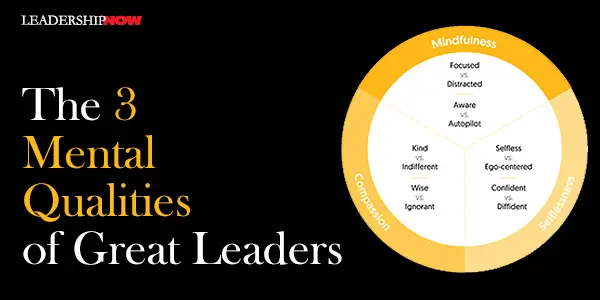
L In The Mind of the Leader, authors Rasmus Hougaard and Jaqueline Carter of the Potential Project, report that there are three mental qualities that stand out as being foundational for leaders today: Mindfulness, Selflessness, and Compassion. They call it MSC Leadership. All three work together and enrich the others. 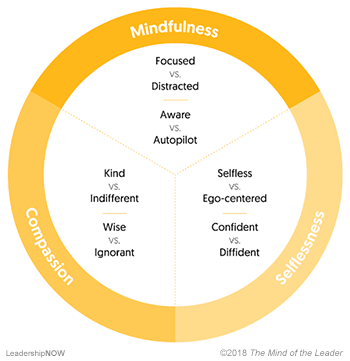 Mindfulness Mindfulness is about managing your attention and in turn managing your thoughts. Mindfulness enables us to respond to our circumstances instead of reacting. The two key qualities of mindfulness are focus and awareness. These two qualities “help us to be mentally agile and effective.” “As your mindfulness increases, your perception of ‘self’ starts to change. More specifically, a stronger sense of selfless confidence arises, helping you develop the second quality of MSC Leadership: selflessness. Selflessness They describe selflessness as “the wisdom of getting out of your own way, the way of your people, and the way of your organization to unleash the natural flow of energy that people bring to work. Selflessness combines strong self-confidence with a humble intention to be of service.” It is interesting the way they put that. Selflessness is often thought of as weak by the uninitiated. It is important that selflessness is combined with self-confidence. You become an enabler. “You are not worried about being taken advantage of, because you have the confidence to speak up for yourself if needed. At the same time, you’re not driven by your own interests. You have a strong focus on the well-being of your people and your organization.” This is a tough one for many leaders. According to a study completed at the University of California, Berkley, “when many leaders start to feel powerful, their more benevolent qualities start to decline. Leaders are three times more likely than lower-level employees to interrupt coworkers, multitask during meetings, raise their voices, and say insulting things.” Also, they are more likely to be rude, selfish, and unethical. We have seen many leaders that think they are above the mores of everyone else. It’s not easy to keep yourself in perspective. Mindfulness plays a big part in that. As we become more selfless, “we naturally begin attending more to other people: we show more interest in them and offer more care. In this way, compassion arises as a natural outgrowth of selflessness.” Compassion Compassion is benevolent leadership. “It’s the ability to understand others’ perspectives and use that as a catalyst for supportive action.” Compasion combines with wisdom. Wisdom gives compassion a compass so that choices can be made that are thoughtful and holistic. A compassionate organizational culture “supports positive intentions toward others, and at the same time instills the wisdom and professionalism in everyone to make tough choices. This includes sometimes doing things that are difficult bit will benefit the culture and the organization in the long term.” MSC Leadership begins with you—inwardly—and then flows outward to your people and then your organizational culture as a whole. “It requires that we take an unflinching look at ourselves, at how we interact with our people, and at how our organizations operate.” The Mind of the Leader looks at this whole process and provides practical methods to apply each of these three qualities of mind to your leadership. This book provides a well-articulated and comprehensive look at these essential qualities of leadership. 
Posted by Michael McKinney at 11:10 PM
03.19.18

Brand-Culture Fusion: Are You Who You Say You Are?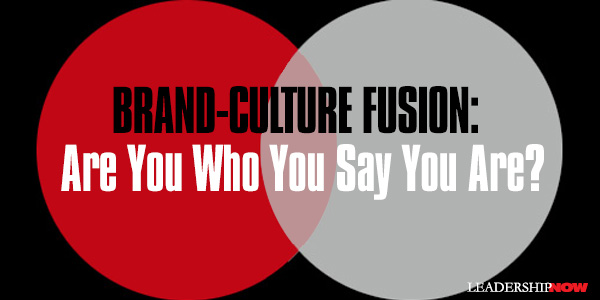
I In Fusion, Denise Lee Yohn makes the case that “you can unleash great power when you fuse together your organization’s two nuclei: your culture—the way the people in your organization behave and the attitudes and belief that inform then (i.e., “the way we do things around here”)—and your brand or brand identity, how your organization is understood by customers and other stakeholders.” She notes that often a company creates a mission statement that states what they want the business to do to create value for their stakeholders and a separate and different brand statement about what they want to be known for. This makes no sense. They should be the same. It simply doesn’t make sense to specify the values through which you engage your employees if those aren’t linked to the way you want your employees to engage customers. Instead, you should bridge the gulf between organizational and brand values by using one set of core values to describe the unique way you do things on the inside and the outside. Your values should function as the “operating instructions” of your organization—that is, they should inform, inspire, and instruct the day-to-day mindset and behaviors of your people. Denise identifies nine brand types: Disruptive, conscious, service, innovative, value, performance, luxury, style, and experience brands. She recommends that you first identify your main brand type that your organization falls into and then identify the kind of culture required to deliver on it. Do the values that currently exist in your organization align with those that correspond to your brand type? Are you who you say you are? Your communications, policies and procedures, compensation, environment, and rituals should reflect the values that exist in your organization. Denise offers a number of ways to do that. It is difficult to transform your culture to define your brand. It’s easier to define your brand by your culture. In some situations, you’re actually better off allowing your culture to lead your brand. If your convictions are so strong that you are more committed to promoting your purpose and values than achieving and particular business or brand goal, then you should prioritize your culture as the driver of your brand identity. Or if you operate in the public sector or yours is an institution such as a science or faith-based organization where a well-defined brand was not needed in the past, you can shape a more authentic brand identity through the inherent values of your people than through an eternal or contrived aspiration. So long as your culture is not fundamentally toxic or dysfunctional, you can use it to shape your brand. Take the FUSION Assessment to determine your “desired culture”—the culture you ought to cultivate to support and advance your brand identity, or the brand identity you’d like to evolve to. You’ll also have an opportunity to assess how far off you are from your desired culture and to pinpoint where you need to make changes in your brand or culture (or both) to fuse them together. 
Posted by Michael McKinney at 11:37 PM
03.14.18

Timeless: 10 Enduring Practices of Apex Leaders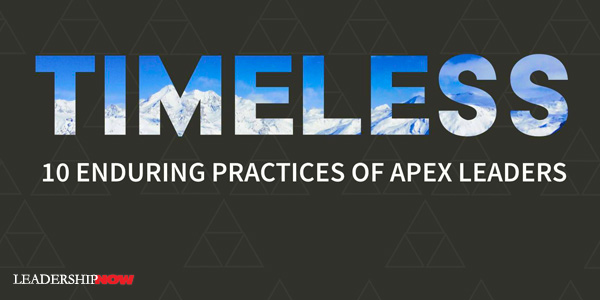
T Dodd has selected the 10 key practices that Apex Leaders have in common. While character, patience and empathy are important for a leader to sustain their leadership, they are not necessarily the behaviors and practices needed to get to the top of their chosen profession. To be sure, Dodd writes, “there are times when a leader’s talent can take them to places where their character cannot sustain them.” But that’s another story. Here, Dodd focuses on the achievement side of the equation. What is required to be the best at what you do? Brian Dodd is the Director of New Ministry Relationships for Injoy Stewardship Solutions an organization founded by John Maxwell. While Timeless will resonate with Christian leaders, the principles apply across all organizations and contexts. As readers of his blog have come to expect, Dodd draws on many examples from the world of sports. All of these principles are found in scripture and are being successfully applied by Apex Leaders in organizations of all types. Here are 10 things Apex Leaders have done and will always do to achieve great success with Dodd’s insights: Apex Leaders Build Great Teams
Apex Leaders Are Humble
Apex Leaders Continually Improve
Apex Leaders Work Hard – Very Hard
Apex Leaders Form Strong Relationships
Apex Leaders Make Others Better
Apex Leaders Show Consistency
Apex Leaders Give Generously
Apex Leaders Lead by Example
Apex Leaders Deliver Results
A leaders character and people skills make someone want to follow them. The ability to deliver results determines if someone actually will follow them. 
Posted by Michael McKinney at 11:18 AM
03.12.18

Meltdown: Why Our Systems Fail and What We Can Do About It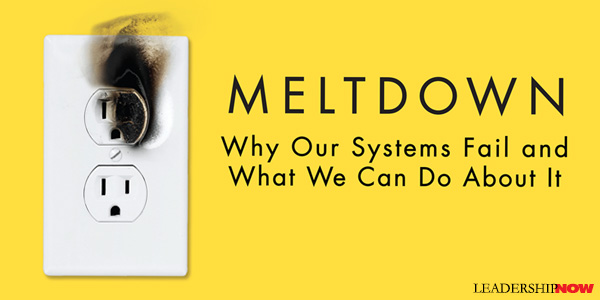
W As systems become more complex, we are more vulnerable to unexpected system failures. In Meltdown, the authors examine a fatal D.C. Metro train accident, the Three Mile Island disaster, the collapse of Enron, the 2012 meltdown of Knight Capital, the Flint water crisis, and the 2017 Oscars mix-up, among other meltdowns, and discover that while these failures stem from very different problems, their underlying causes are surprisingly similar. These stories told here are a compelling look behind the scenes of why failures occur in today’s many complex systems. Using sociologist professor Charles Perrow’s theory that as a system’s complexity and “tight coupling” (a lack of slack between different parts—no margin) increase the chance of a meltdown. In other words, these failures are driven by “the connections between the different parts, rather than the parts themselves.” Some systems are linear and in these systems, the source of the breakdown is obvious. But as systems become complex, as at a nuclear power plant, the parts of the system interact in hidden and unexpected ways. Because these systems are more like a web, when they breakdown, it is difficult to figure out exactly what is wrong. And worse still, it is almost impossible to predict where it will go wrong and all of the possible consequences of even a small failure somewhere in the system. As more and more of our systems become more complex and tightly coupled, what do you do? How do we keep up with our increasingly complex systems? Oddly enough, safety features are not the answer. They become part of the system and thereby add to the complexity. And when something goes wrong, we like to add even more safety features into the system. “It’s like the old fable: cry wolf every eight minutes, and soon people will tune you out. Worse, when something does happen, constant alerts make it hard to sort out the important from the trivial.” There are ways to make complex systems more transparent. For example, using premortems. Imagine in the future your project has failed. Write down all of the reasons why you think it happened. A 1989 study showed that premortems or prospective hindsight boost our ability to identify reasons why an outcome might occur and therefore deal with the potential problems before they occur. We also should encourage feedback and sharing of failures and near-misses. “By openly sharing stories of failures and near failures—without blame or revenge—we can create a culture in which people view errors as an opportunity to learn rather than as the impetus for a witch hunt.” Encourage dissent with a more open-leadership style. People in power tend to dismiss other’s opinions. Leaders should speak last. You have to work on the culture. Ironically, the authors note, introducing anonymous feedback actually highlights the dangers of speaking up. Bring in outsiders and add diversity of thought. Outsiders will see things we don’t and are more willing to ask uncomfortable questions. Also in a more diverse environment, we tend to be more vigilant and question more. When we are around people just like us, we tend to trust their judgment which can lead to too much conformity. “Diversity is like a speed bump. It’s a nuisance, but it snaps us out of our comfort zone and makes it hard to barrel ahead without thinking. It saves us from ourselves.” Transparent design matters. We need to see what is going on under the hood. Being able to see the state of a system by simply looking at it can be an important safeguard. These are just a sampling of the ways we can learn to manage complex systems. This doesn’t mean we should take fewer risks. On the contrary, these solutions—structured decision tools, diverse teams, and norms that encourage healthy skepticism and dissent—“tend to fuel, rather than squelch, innovation and productivity. Adopting these solutions is a win-win.” We can make our systems more forgiving of our mistakes by thinking critically and clearly about our own systems. How many things have to go right at the same time for this to work? Can we simplify it? How can we add margin? 
Posted by Michael McKinney at 06:54 PM
03.07.18

9 Secrets to Creating a Successful Future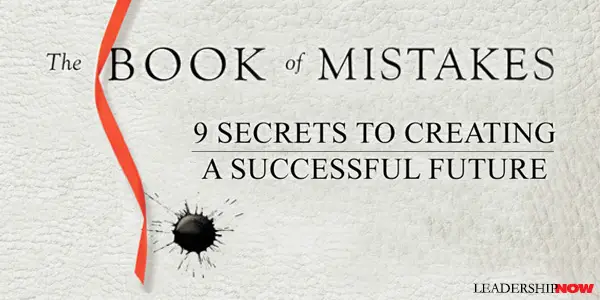
I In The Book of Mistakes, Skip Prichard has created for us an absorbing fable of a young man and a young woman who are both part of a mysterious journey to learn the nine mistakes that tend to trip us up. While they make sense, they are not always intuitive. The truths presented here often stand between us and success. The main story follows David whose life of promise has become ordinary. Through a life-altering event, he has a chance meeting with an Old Man who sets him on a journey that will take him to meet nine unique people who will share the nine mistakes and the impact these mistakes have had on their own lives. The nine mistakes are framed by three universal laws that are found in an ancient book of wisdom. The parallel story is about Aria and how she comes to be the keeper of the book of wisdom and how she learns of the three laws. 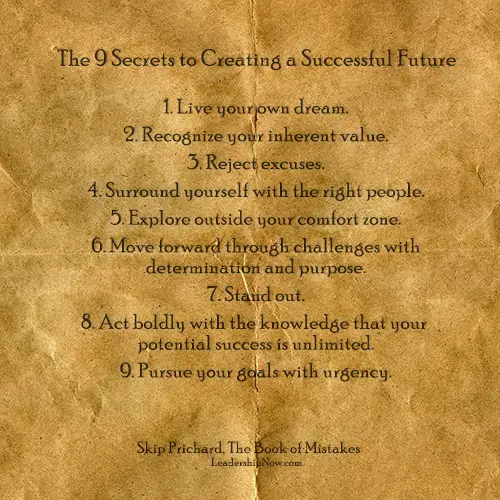 Printable Graphic The three universal laws enable the nine secrets to creating a successful future. To avoid the nine mistakes, you need to: 1. Live your own dream. “A life choreographed by someone else is not our finest performance.” 2. Recognize your inherent value. “Don’t accept the limitations others put on you.” “Others are so quick to define us. They set expectations. They don’t realize when we’ve changed.” 3. Reject excuses. “Behind every excuse is a door to greatness.” “If you want to take your life back, take your thoughts back.” 4. Surround yourself with the right people. “Your friends determine your fate.” “Replace naysayers, doubters, and energy drainers with encouragers, winners, and motivators.” 5. Explore outside your comfort zone. “Mediocrity is the end result of too much comfort.” 6. More forward through challenges with determination and purpose. “Don’t let current circumstances define your destiny.” There will be setbacks but “It doesn’t mean you have to be good at everything or do everything, but if you think it’s a skill that you need to fulfill your purpose, you need to find a way through it.” 7. Stand out. “Standing out is as simple as consistently outperforming expectations.” 8. Act boldly with the knowledge that your potential success is unlimited. “The only limitations you need to worry about are the ones in your mind.” “Helping others magnetizes people to your cause and enhances your success.” 9. Pursue your goals with urgency. Live each day as if it’s your last and your first. “Your last keeps you focused on what really matters. You think about people, about loving those around you. Your first is important because you also must have a longer view, or you will never accomplish the goals that are hard and take longer.” Each mentor David encounters has their own story that illuminates the mistake they share with us. Their experiences help to identify and relate to the mistake and help us to take action to avoid the mistake in the future. Prichard brings a lot of wisdom to each of these common life issues. The story is engaging for young and old. Share this book widely because these are the kinds of mistakes that create regret down the road. At the end of your life these are the things that you look back on and wonder why no one ever told you about these pitfalls. We are never too old to learn them and some are more difficult to deal with because of the baggage that often accompanies them. Now is the time to set your course. 
Posted by Michael McKinney at 10:45 AM
03.05.18

6 Steps to Building a Community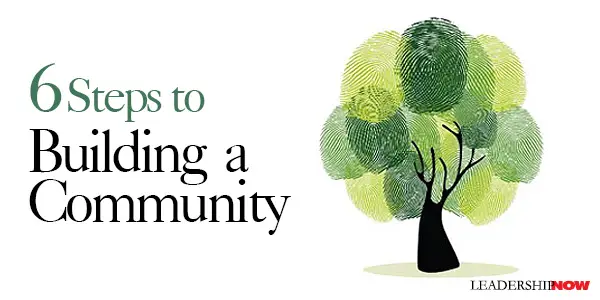
I Organizational health is facilitated by building community within your organization. It’s not easy, and it can’t be forced. Community is a long-term solution to engagement, commitment, and talent retention. In The Power of Community, Howard Partridge has broken down the process of building a community within your organization into three keys with six action steps. Support The first key to building community in your business is supporting your team members. “Many employees feel no one care about them. What if you started helping your team members reach their goals in life? This is a major key to the whole idea of community. In order to get support, we have to give support.” So this is where you begin: 1. Value True Community
2. Pursue Champion Connection
Encouragement
3. Inspire Emotional Trust
4. Practice Gift Exchange
Accountability The final key to building community in your business is accountability—the ability to accept responsibility for one’s own actions. “Accountability is key to becoming the person you were created to be. That’s because it is only by being accountable that you can discover and develop your gifts and help others discover and develop theirs.” This means that you first “have to take responsibility for your own actions, be respectful to your team members, be open to them, and allow yourself to be vulnerable. You also have to be willing to admit when you’re wrong, confess that you don’t have all the answers, and ask your team for feedback on how you’re doing as a leader.” Build accountability by: 5. Invite Openhearted Encounters
6. Build Growth PODS
You can begin the process by creating your first POD. A free POD template for each of the chapters of this book are available to download at HowardPartridge.com/PODS Go build your community. 
Posted by Michael McKinney at 07:45 AM
03.01.18

First Look: Leadership Books for March 2018Here's a look at some of the best leadership books to be released in March 2018. Don't miss out on other great new and future releases this year.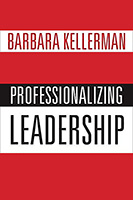 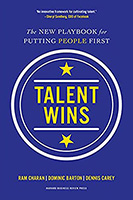 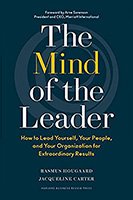 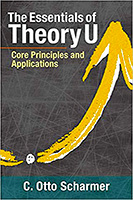 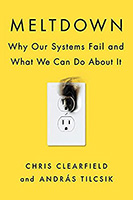
For bulk orders call 1-800-423-8273  Build your leadership library with these specials on over 39 titles. All titles are at least 40% off the list price and are available only in limited quantities. "Today a reader, tomorrow a leader." — Margaret Fuller
Posted by Michael McKinney at 08:31 AM
|
BUILD YOUR KNOWLEDGE


How to Do Your Start-Up Right STRAIGHT TALK FOR START-UPS 
Grow Your Leadership Skills NEW AND UPCOMING LEADERSHIP BOOKS 
Leadership Minute BITE-SIZE CONCEPTS YOU CAN CHEW ON 
Classic Leadership Books BOOKS TO READ BEFORE YOU LEAD |
|